Research Proposal: Safety and Health in Confined Environments
VerifiedAdded on 2021/06/16
|14
|3535
|52
Project
AI Summary
This research proposal examines the effects of occupational safety and health risks on workers in confined spaces, specifically manholes. It begins with an introduction to confined spaces and the importance of workplace safety and health frameworks, emphasizing the need for organizations to understand and implement safety measures. The research rationale highlights the increasing trend of accidents in confined spaces and the growing awareness of safety frameworks. The aim is to evaluate the impact of workplace health and safety frameworks on workers, with objectives including understanding the framework, confined spaces, risk factors, and mitigation strategies. The research questions address the framework, confined spaces, the impact of the framework on workers, potential risks, and mitigation. The methodology employs a pragmatic research approach, combining positivism and interpretivism. The research design uses a deductive approach, building upon existing theories and concepts. The proposal outlines exploratory, explanatory, and descriptive research designs to guide the investigation. The proposal aims to contribute to a better understanding of the effects of health and safety risks on workers and provide a framework for minimizing those risks.

Running head: RESEARCH PROPOSAL
Effects of Occupational Safety and Health Risks Affecting Workers in Confined Space
(Manhole) Environment
Name of the Student:
Name of the University:
Author’s Note:
Effects of Occupational Safety and Health Risks Affecting Workers in Confined Space
(Manhole) Environment
Name of the Student:
Name of the University:
Author’s Note:
Paraphrase This Document
Need a fresh take? Get an instant paraphrase of this document with our AI Paraphraser
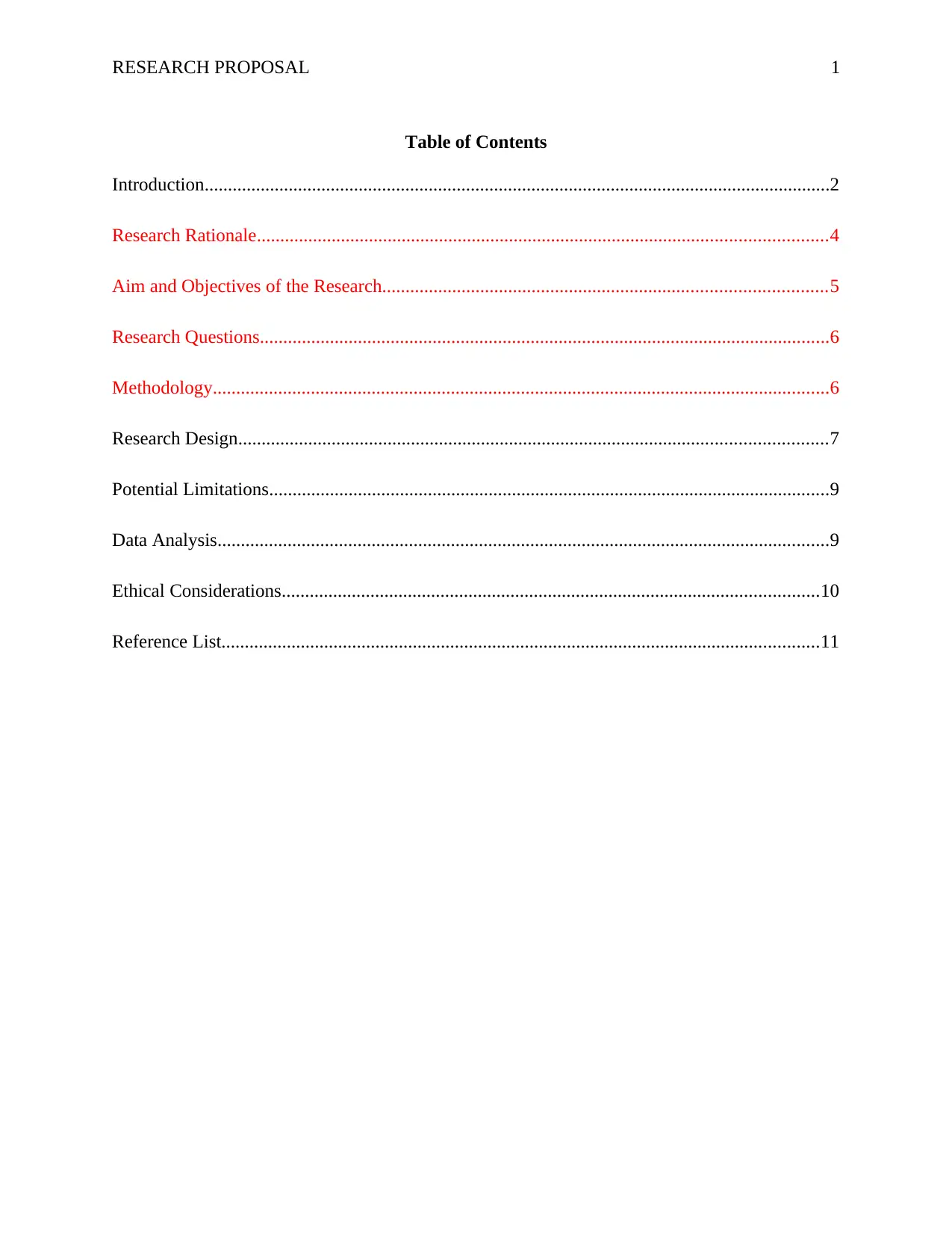
RESEARCH PROPOSAL 1
Table of Contents
Introduction......................................................................................................................................2
Research Rationale..........................................................................................................................4
Aim and Objectives of the Research...............................................................................................5
Research Questions..........................................................................................................................6
Methodology....................................................................................................................................6
Research Design..............................................................................................................................7
Potential Limitations........................................................................................................................9
Data Analysis...................................................................................................................................9
Ethical Considerations...................................................................................................................10
Reference List................................................................................................................................11
Table of Contents
Introduction......................................................................................................................................2
Research Rationale..........................................................................................................................4
Aim and Objectives of the Research...............................................................................................5
Research Questions..........................................................................................................................6
Methodology....................................................................................................................................6
Research Design..............................................................................................................................7
Potential Limitations........................................................................................................................9
Data Analysis...................................................................................................................................9
Ethical Considerations...................................................................................................................10
Reference List................................................................................................................................11

RESEARCH PROPOSAL 2
Introduction
A confined place is characterized as a place which is by virtue enclosed in nature, it is
quite likely that there would be foreseeable chances of risk and this includes places like any
chamber, pit, tank, vat, tunnel, pipe, hatch, shaft or silo and sewer where such risk may arise.
Workplace safety and health emphasizes over the legal certification and registration
requirements as well as the surveillance and monitoring coupled with accident and workplace
injury compensations (Frey and Osborne, 2017). All the organizations operating in the highly
competitive marketplace are essentially required to understand the Workplace Safety and Health
requirements appropriately so as to improve the safety of the workplace. As arousal of risk in the
confined place is quite likely it is also necessary for the organizations whose employees work in
these areas are essentially required to enact certain health and safety frameworks so as to provide
the employees with the essential level of security (Frumkin, 2016). This research work will
solely focus on determining the effect of this health and safety risks which may arise in the
context of working in a confined place. In order to achieve the desired outcome the research
work will primarily focus on developing a crisp idea about the health and safety framework at
the workplace. Afterwards it will attempt to recognize the risk factors which are intricately
related to the confined work environment. Furthermore, the impact of the workplace health and
safety framework in mitigating the risk factors of confined workplace and thereby affecting the
workers will be evaluated and analyzed.
The workplace health and safety is generally characterized as the philosophy of
anticipating, evaluating, recognizing as well as hazards that may arise in or from the workplace
which in turn could adversely affect the health of the workers (Mullen et al., 2017). This also
takes into consideration the possible impacts on the environment as well as on the surrounding
Introduction
A confined place is characterized as a place which is by virtue enclosed in nature, it is
quite likely that there would be foreseeable chances of risk and this includes places like any
chamber, pit, tank, vat, tunnel, pipe, hatch, shaft or silo and sewer where such risk may arise.
Workplace safety and health emphasizes over the legal certification and registration
requirements as well as the surveillance and monitoring coupled with accident and workplace
injury compensations (Frey and Osborne, 2017). All the organizations operating in the highly
competitive marketplace are essentially required to understand the Workplace Safety and Health
requirements appropriately so as to improve the safety of the workplace. As arousal of risk in the
confined place is quite likely it is also necessary for the organizations whose employees work in
these areas are essentially required to enact certain health and safety frameworks so as to provide
the employees with the essential level of security (Frumkin, 2016). This research work will
solely focus on determining the effect of this health and safety risks which may arise in the
context of working in a confined place. In order to achieve the desired outcome the research
work will primarily focus on developing a crisp idea about the health and safety framework at
the workplace. Afterwards it will attempt to recognize the risk factors which are intricately
related to the confined work environment. Furthermore, the impact of the workplace health and
safety framework in mitigating the risk factors of confined workplace and thereby affecting the
workers will be evaluated and analyzed.
The workplace health and safety is generally characterized as the philosophy of
anticipating, evaluating, recognizing as well as hazards that may arise in or from the workplace
which in turn could adversely affect the health of the workers (Mullen et al., 2017). This also
takes into consideration the possible impacts on the environment as well as on the surrounding
⊘ This is a preview!⊘
Do you want full access?
Subscribe today to unlock all pages.

Trusted by 1+ million students worldwide
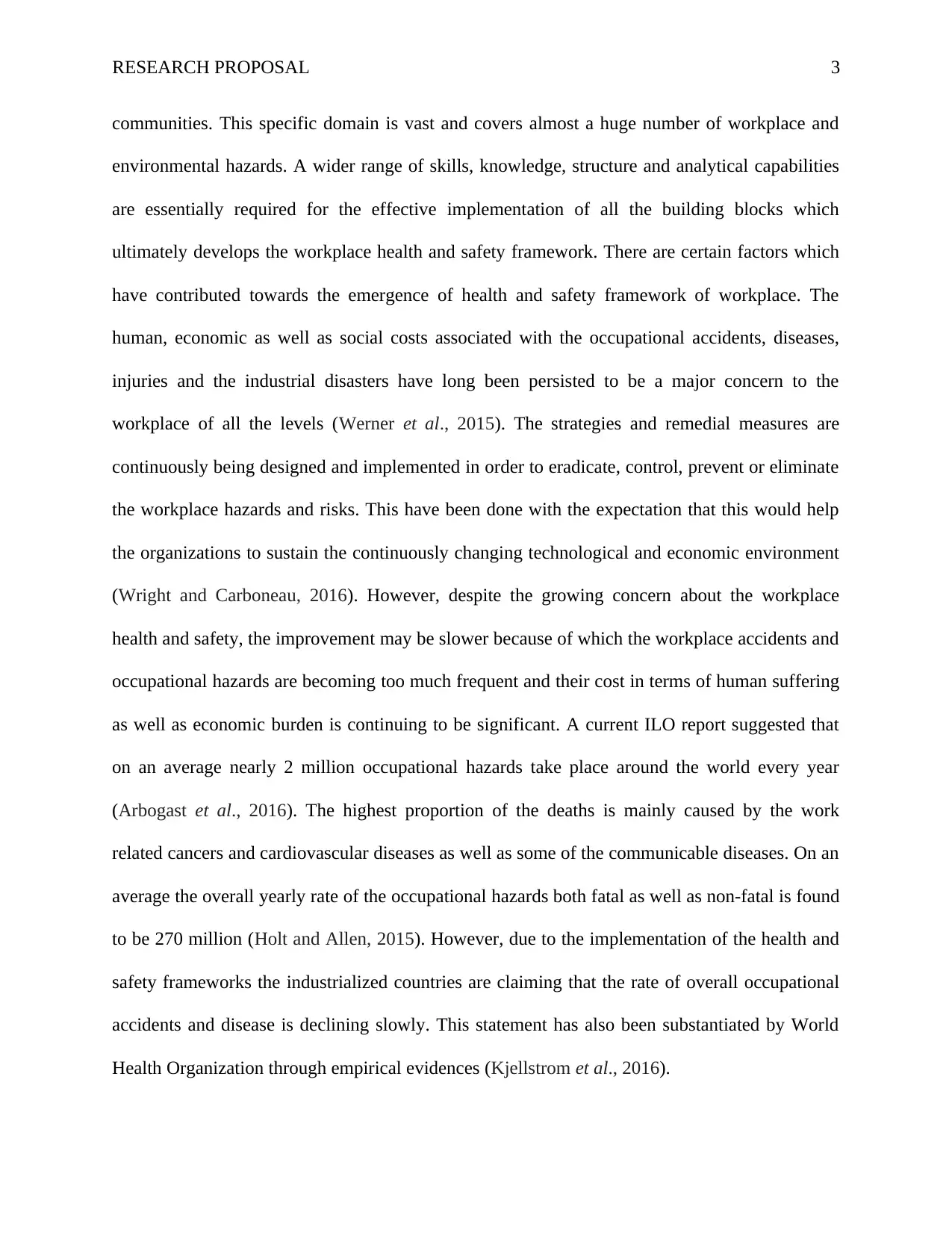
RESEARCH PROPOSAL 3
communities. This specific domain is vast and covers almost a huge number of workplace and
environmental hazards. A wider range of skills, knowledge, structure and analytical capabilities
are essentially required for the effective implementation of all the building blocks which
ultimately develops the workplace health and safety framework. There are certain factors which
have contributed towards the emergence of health and safety framework of workplace. The
human, economic as well as social costs associated with the occupational accidents, diseases,
injuries and the industrial disasters have long been persisted to be a major concern to the
workplace of all the levels (Werner et al., 2015). The strategies and remedial measures are
continuously being designed and implemented in order to eradicate, control, prevent or eliminate
the workplace hazards and risks. This have been done with the expectation that this would help
the organizations to sustain the continuously changing technological and economic environment
(Wright and Carboneau, 2016). However, despite the growing concern about the workplace
health and safety, the improvement may be slower because of which the workplace accidents and
occupational hazards are becoming too much frequent and their cost in terms of human suffering
as well as economic burden is continuing to be significant. A current ILO report suggested that
on an average nearly 2 million occupational hazards take place around the world every year
(Arbogast et al., 2016). The highest proportion of the deaths is mainly caused by the work
related cancers and cardiovascular diseases as well as some of the communicable diseases. On an
average the overall yearly rate of the occupational hazards both fatal as well as non-fatal is found
to be 270 million (Holt and Allen, 2015). However, due to the implementation of the health and
safety frameworks the industrialized countries are claiming that the rate of overall occupational
accidents and disease is declining slowly. This statement has also been substantiated by World
Health Organization through empirical evidences (Kjellstrom et al., 2016).
communities. This specific domain is vast and covers almost a huge number of workplace and
environmental hazards. A wider range of skills, knowledge, structure and analytical capabilities
are essentially required for the effective implementation of all the building blocks which
ultimately develops the workplace health and safety framework. There are certain factors which
have contributed towards the emergence of health and safety framework of workplace. The
human, economic as well as social costs associated with the occupational accidents, diseases,
injuries and the industrial disasters have long been persisted to be a major concern to the
workplace of all the levels (Werner et al., 2015). The strategies and remedial measures are
continuously being designed and implemented in order to eradicate, control, prevent or eliminate
the workplace hazards and risks. This have been done with the expectation that this would help
the organizations to sustain the continuously changing technological and economic environment
(Wright and Carboneau, 2016). However, despite the growing concern about the workplace
health and safety, the improvement may be slower because of which the workplace accidents and
occupational hazards are becoming too much frequent and their cost in terms of human suffering
as well as economic burden is continuing to be significant. A current ILO report suggested that
on an average nearly 2 million occupational hazards take place around the world every year
(Arbogast et al., 2016). The highest proportion of the deaths is mainly caused by the work
related cancers and cardiovascular diseases as well as some of the communicable diseases. On an
average the overall yearly rate of the occupational hazards both fatal as well as non-fatal is found
to be 270 million (Holt and Allen, 2015). However, due to the implementation of the health and
safety frameworks the industrialized countries are claiming that the rate of overall occupational
accidents and disease is declining slowly. This statement has also been substantiated by World
Health Organization through empirical evidences (Kjellstrom et al., 2016).
Paraphrase This Document
Need a fresh take? Get an instant paraphrase of this document with our AI Paraphraser

RESEARCH PROPOSAL 4
A confined space is characterized as any chamber, manhole, tank, silo, vat or pipe or any
other enclosed space where, dangerous gaseous elements, fumes or vapors are liable to be
present to such an extent that it can give rise to the risk of fire or explosion. The supply of
oxygen in such places is likely to be inadequate for sustaining life and there may be a risk of
engulfment through materials (Faris, 2017). There are a few characteristic features through
which the confined place can be categorized and these are stated as follows,
These places are not designed or intended to be occupied by the human beings.
These places possesses restricted entrance or exit by the virtue of its location or means or
size (Pearce and Rusczek, 2017)..
Characteristically these places may contain materials which may in turn bury or trap
people.
Can pose significant risk before the health and safety of an individual who enters into
these place because of one or more of the issues. Such as the design, location or
atmosphere. The materials or the substances contained within those places and may be
because of the work activities which are being carried out within that place (Topie et al.,
2015).
It is necessary to mention that a “responsible person” in the context of the person who is
entering into the confined space is the employer of that person or the expert personnel under
whose direction that person is entering or working within the confined space (Biddison et al.,
2016).
A confined space is characterized as any chamber, manhole, tank, silo, vat or pipe or any
other enclosed space where, dangerous gaseous elements, fumes or vapors are liable to be
present to such an extent that it can give rise to the risk of fire or explosion. The supply of
oxygen in such places is likely to be inadequate for sustaining life and there may be a risk of
engulfment through materials (Faris, 2017). There are a few characteristic features through
which the confined place can be categorized and these are stated as follows,
These places are not designed or intended to be occupied by the human beings.
These places possesses restricted entrance or exit by the virtue of its location or means or
size (Pearce and Rusczek, 2017)..
Characteristically these places may contain materials which may in turn bury or trap
people.
Can pose significant risk before the health and safety of an individual who enters into
these place because of one or more of the issues. Such as the design, location or
atmosphere. The materials or the substances contained within those places and may be
because of the work activities which are being carried out within that place (Topie et al.,
2015).
It is necessary to mention that a “responsible person” in the context of the person who is
entering into the confined space is the employer of that person or the expert personnel under
whose direction that person is entering or working within the confined space (Biddison et al.,
2016).
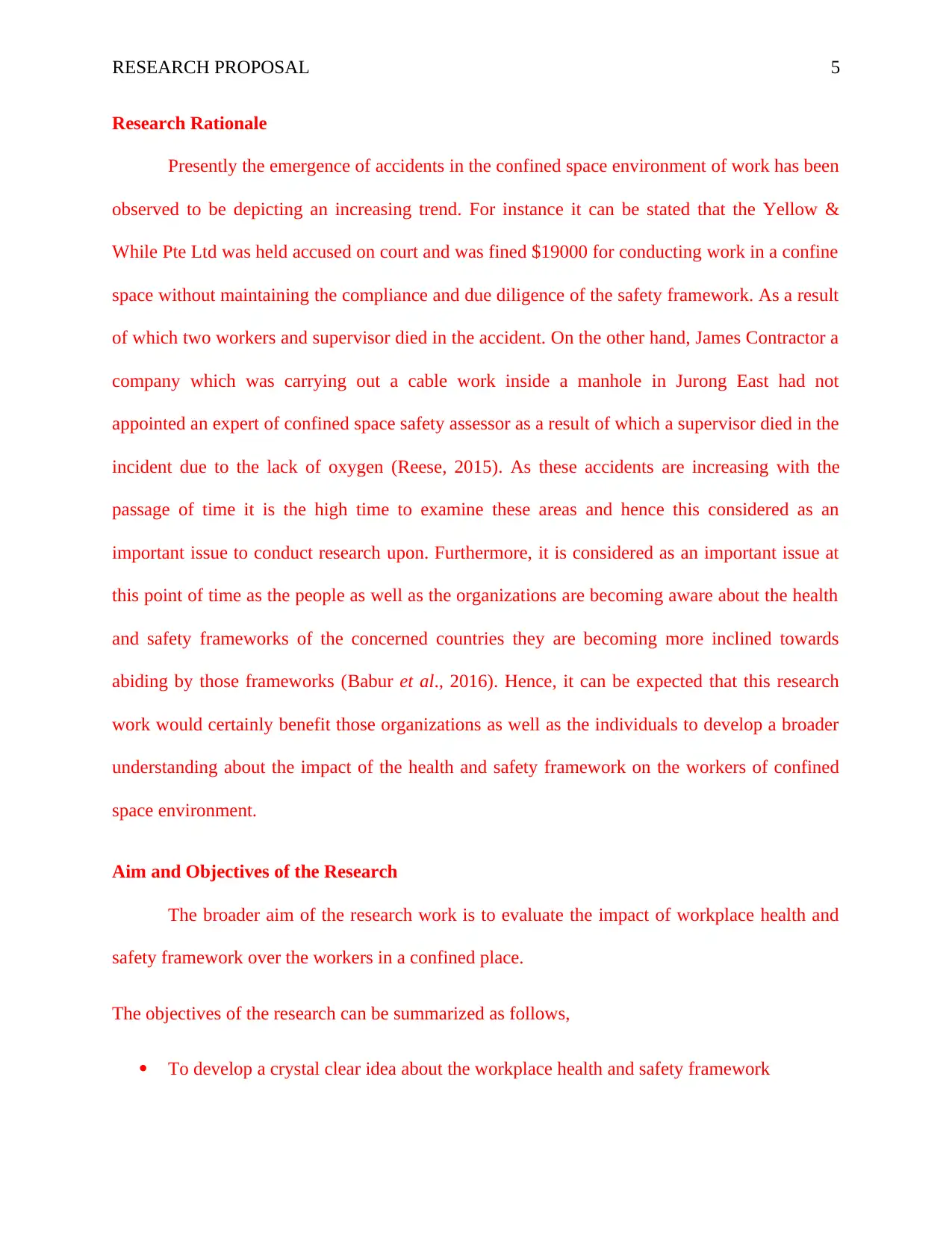
RESEARCH PROPOSAL 5
Research Rationale
Presently the emergence of accidents in the confined space environment of work has been
observed to be depicting an increasing trend. For instance it can be stated that the Yellow &
While Pte Ltd was held accused on court and was fined $19000 for conducting work in a confine
space without maintaining the compliance and due diligence of the safety framework. As a result
of which two workers and supervisor died in the accident. On the other hand, James Contractor a
company which was carrying out a cable work inside a manhole in Jurong East had not
appointed an expert of confined space safety assessor as a result of which a supervisor died in the
incident due to the lack of oxygen (Reese, 2015). As these accidents are increasing with the
passage of time it is the high time to examine these areas and hence this considered as an
important issue to conduct research upon. Furthermore, it is considered as an important issue at
this point of time as the people as well as the organizations are becoming aware about the health
and safety frameworks of the concerned countries they are becoming more inclined towards
abiding by those frameworks (Babur et al., 2016). Hence, it can be expected that this research
work would certainly benefit those organizations as well as the individuals to develop a broader
understanding about the impact of the health and safety framework on the workers of confined
space environment.
Aim and Objectives of the Research
The broader aim of the research work is to evaluate the impact of workplace health and
safety framework over the workers in a confined place.
The objectives of the research can be summarized as follows,
To develop a crystal clear idea about the workplace health and safety framework
Research Rationale
Presently the emergence of accidents in the confined space environment of work has been
observed to be depicting an increasing trend. For instance it can be stated that the Yellow &
While Pte Ltd was held accused on court and was fined $19000 for conducting work in a confine
space without maintaining the compliance and due diligence of the safety framework. As a result
of which two workers and supervisor died in the accident. On the other hand, James Contractor a
company which was carrying out a cable work inside a manhole in Jurong East had not
appointed an expert of confined space safety assessor as a result of which a supervisor died in the
incident due to the lack of oxygen (Reese, 2015). As these accidents are increasing with the
passage of time it is the high time to examine these areas and hence this considered as an
important issue to conduct research upon. Furthermore, it is considered as an important issue at
this point of time as the people as well as the organizations are becoming aware about the health
and safety frameworks of the concerned countries they are becoming more inclined towards
abiding by those frameworks (Babur et al., 2016). Hence, it can be expected that this research
work would certainly benefit those organizations as well as the individuals to develop a broader
understanding about the impact of the health and safety framework on the workers of confined
space environment.
Aim and Objectives of the Research
The broader aim of the research work is to evaluate the impact of workplace health and
safety framework over the workers in a confined place.
The objectives of the research can be summarized as follows,
To develop a crystal clear idea about the workplace health and safety framework
⊘ This is a preview!⊘
Do you want full access?
Subscribe today to unlock all pages.

Trusted by 1+ million students worldwide
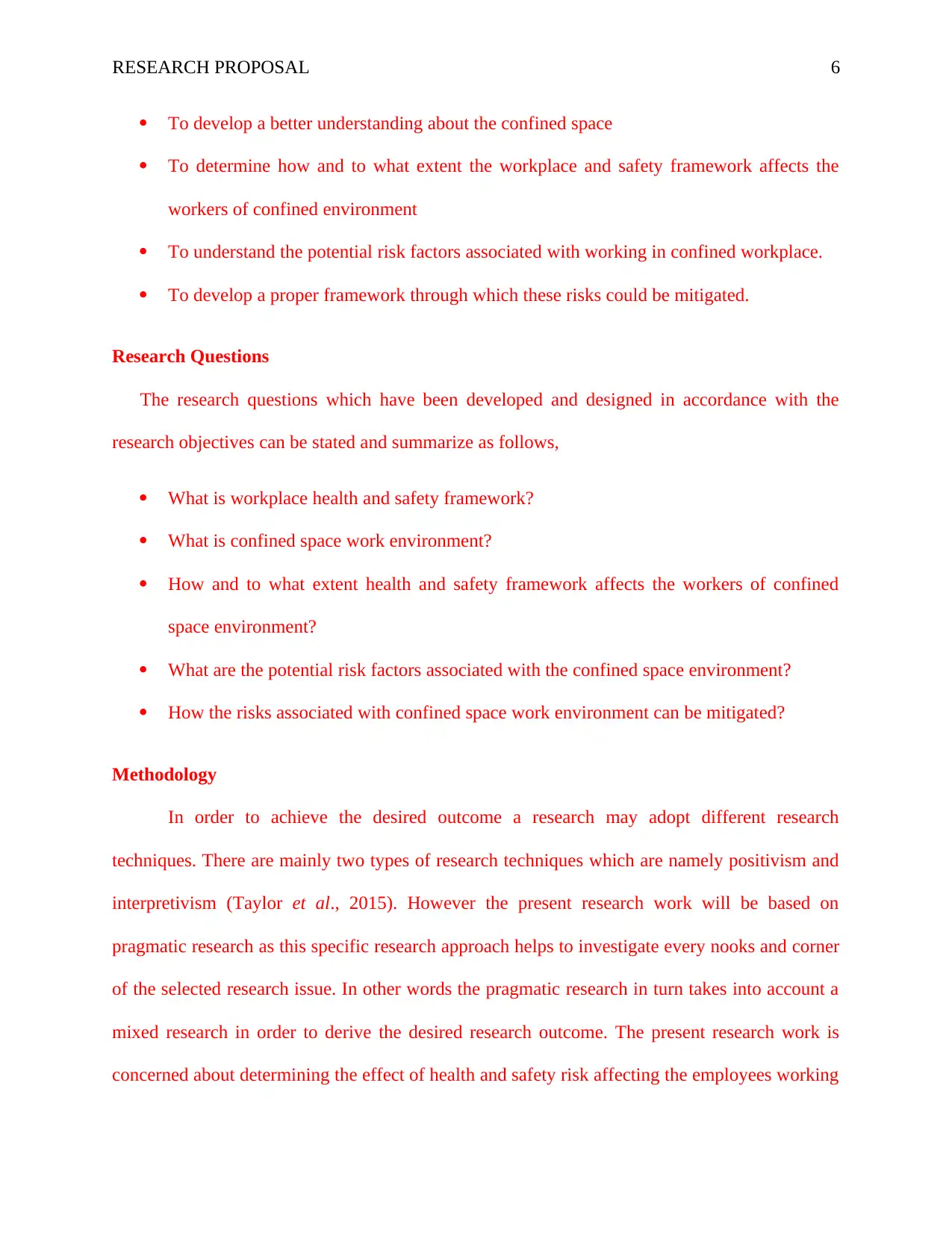
RESEARCH PROPOSAL 6
To develop a better understanding about the confined space
To determine how and to what extent the workplace and safety framework affects the
workers of confined environment
To understand the potential risk factors associated with working in confined workplace.
To develop a proper framework through which these risks could be mitigated.
Research Questions
The research questions which have been developed and designed in accordance with the
research objectives can be stated and summarize as follows,
What is workplace health and safety framework?
What is confined space work environment?
How and to what extent health and safety framework affects the workers of confined
space environment?
What are the potential risk factors associated with the confined space environment?
How the risks associated with confined space work environment can be mitigated?
Methodology
In order to achieve the desired outcome a research may adopt different research
techniques. There are mainly two types of research techniques which are namely positivism and
interpretivism (Taylor et al., 2015). However the present research work will be based on
pragmatic research as this specific research approach helps to investigate every nooks and corner
of the selected research issue. In other words the pragmatic research in turn takes into account a
mixed research in order to derive the desired research outcome. The present research work is
concerned about determining the effect of health and safety risk affecting the employees working
To develop a better understanding about the confined space
To determine how and to what extent the workplace and safety framework affects the
workers of confined environment
To understand the potential risk factors associated with working in confined workplace.
To develop a proper framework through which these risks could be mitigated.
Research Questions
The research questions which have been developed and designed in accordance with the
research objectives can be stated and summarize as follows,
What is workplace health and safety framework?
What is confined space work environment?
How and to what extent health and safety framework affects the workers of confined
space environment?
What are the potential risk factors associated with the confined space environment?
How the risks associated with confined space work environment can be mitigated?
Methodology
In order to achieve the desired outcome a research may adopt different research
techniques. There are mainly two types of research techniques which are namely positivism and
interpretivism (Taylor et al., 2015). However the present research work will be based on
pragmatic research as this specific research approach helps to investigate every nooks and corner
of the selected research issue. In other words the pragmatic research in turn takes into account a
mixed research in order to derive the desired research outcome. The present research work is
concerned about determining the effect of health and safety risk affecting the employees working
Paraphrase This Document
Need a fresh take? Get an instant paraphrase of this document with our AI Paraphraser
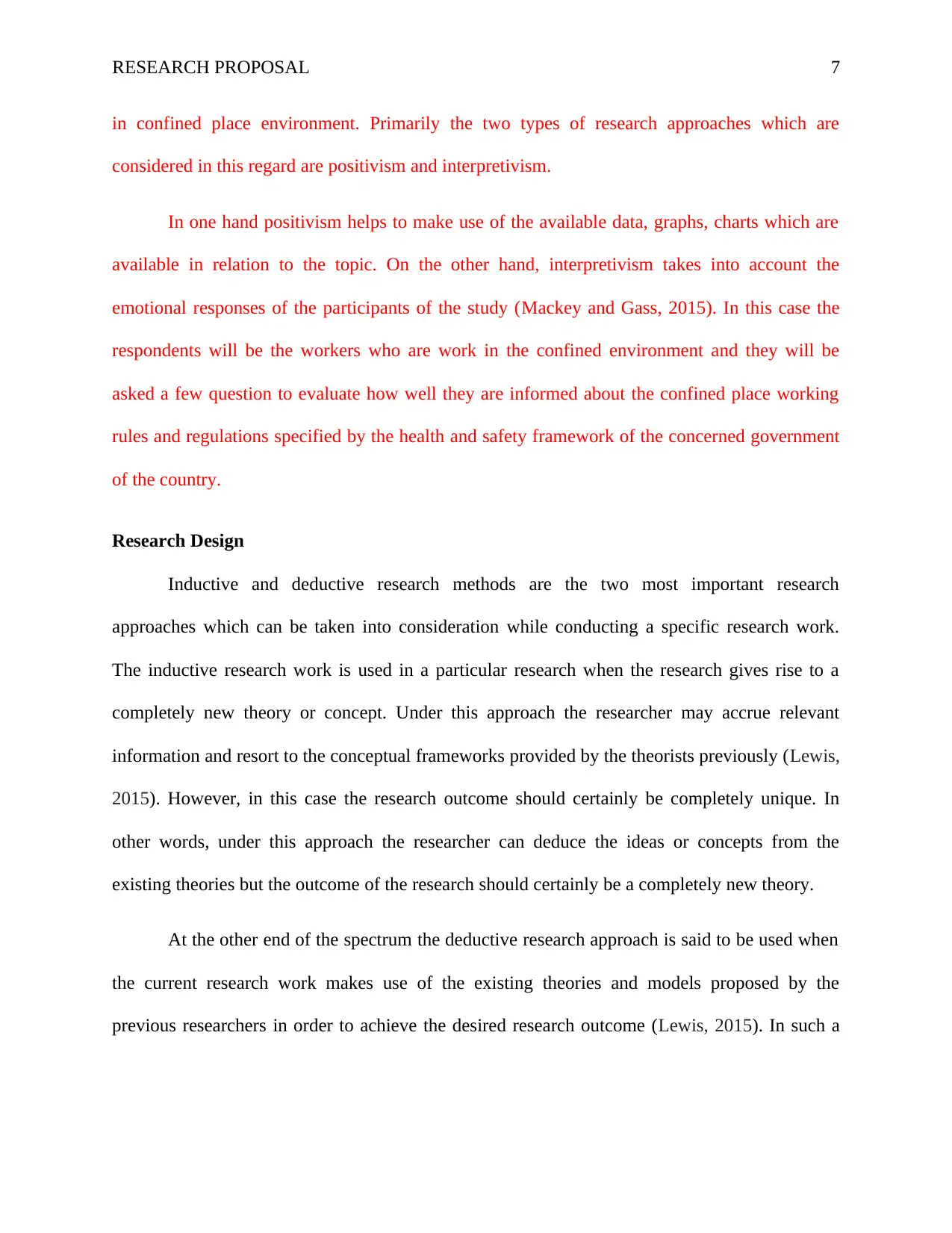
RESEARCH PROPOSAL 7
in confined place environment. Primarily the two types of research approaches which are
considered in this regard are positivism and interpretivism.
In one hand positivism helps to make use of the available data, graphs, charts which are
available in relation to the topic. On the other hand, interpretivism takes into account the
emotional responses of the participants of the study (Mackey and Gass, 2015). In this case the
respondents will be the workers who are work in the confined environment and they will be
asked a few question to evaluate how well they are informed about the confined place working
rules and regulations specified by the health and safety framework of the concerned government
of the country.
Research Design
Inductive and deductive research methods are the two most important research
approaches which can be taken into consideration while conducting a specific research work.
The inductive research work is used in a particular research when the research gives rise to a
completely new theory or concept. Under this approach the researcher may accrue relevant
information and resort to the conceptual frameworks provided by the theorists previously (Lewis,
2015). However, in this case the research outcome should certainly be completely unique. In
other words, under this approach the researcher can deduce the ideas or concepts from the
existing theories but the outcome of the research should certainly be a completely new theory.
At the other end of the spectrum the deductive research approach is said to be used when
the current research work makes use of the existing theories and models proposed by the
previous researchers in order to achieve the desired research outcome (Lewis, 2015). In such a
in confined place environment. Primarily the two types of research approaches which are
considered in this regard are positivism and interpretivism.
In one hand positivism helps to make use of the available data, graphs, charts which are
available in relation to the topic. On the other hand, interpretivism takes into account the
emotional responses of the participants of the study (Mackey and Gass, 2015). In this case the
respondents will be the workers who are work in the confined environment and they will be
asked a few question to evaluate how well they are informed about the confined place working
rules and regulations specified by the health and safety framework of the concerned government
of the country.
Research Design
Inductive and deductive research methods are the two most important research
approaches which can be taken into consideration while conducting a specific research work.
The inductive research work is used in a particular research when the research gives rise to a
completely new theory or concept. Under this approach the researcher may accrue relevant
information and resort to the conceptual frameworks provided by the theorists previously (Lewis,
2015). However, in this case the research outcome should certainly be completely unique. In
other words, under this approach the researcher can deduce the ideas or concepts from the
existing theories but the outcome of the research should certainly be a completely new theory.
At the other end of the spectrum the deductive research approach is said to be used when
the current research work makes use of the existing theories and models proposed by the
previous researchers in order to achieve the desired research outcome (Lewis, 2015). In such a
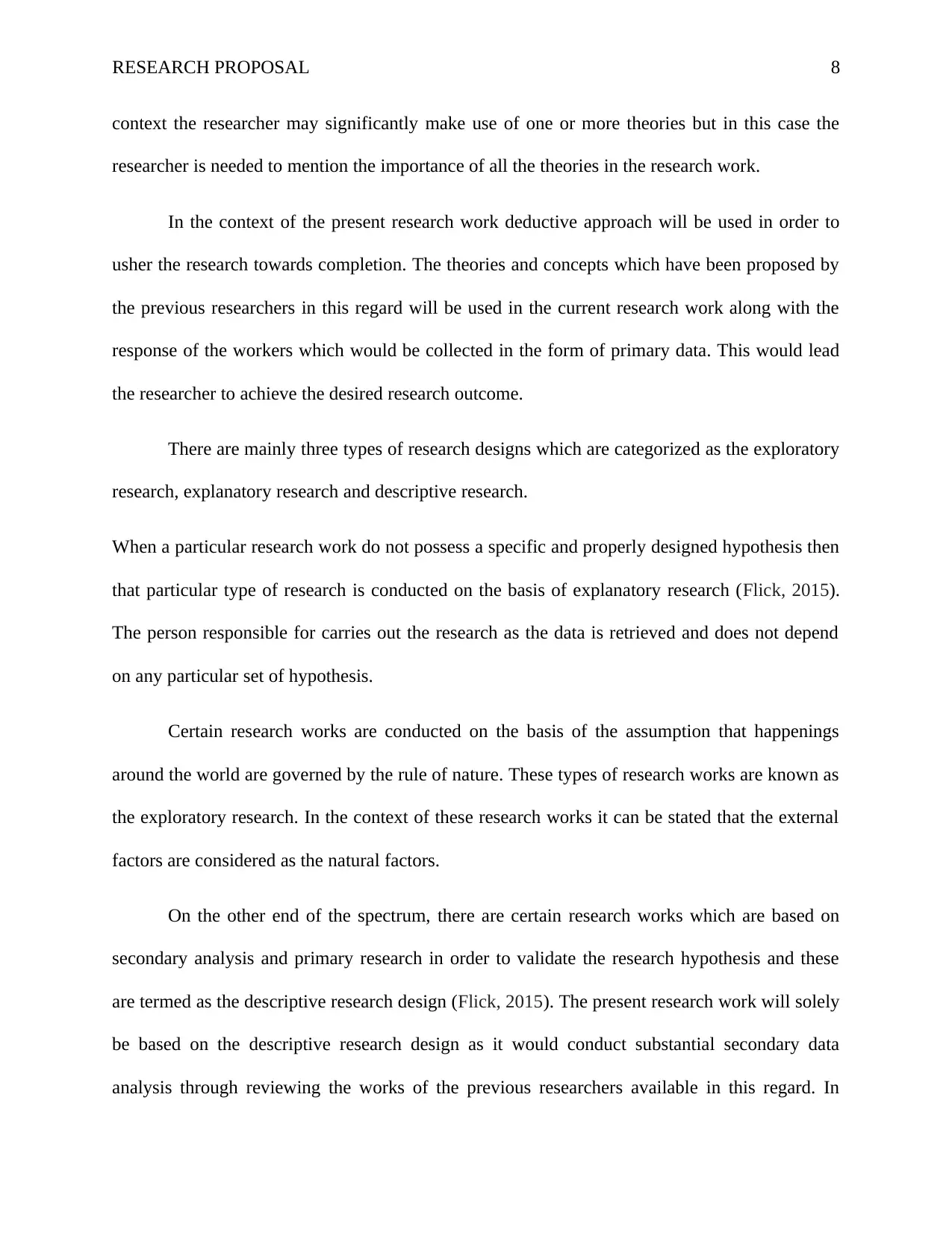
RESEARCH PROPOSAL 8
context the researcher may significantly make use of one or more theories but in this case the
researcher is needed to mention the importance of all the theories in the research work.
In the context of the present research work deductive approach will be used in order to
usher the research towards completion. The theories and concepts which have been proposed by
the previous researchers in this regard will be used in the current research work along with the
response of the workers which would be collected in the form of primary data. This would lead
the researcher to achieve the desired research outcome.
There are mainly three types of research designs which are categorized as the exploratory
research, explanatory research and descriptive research.
When a particular research work do not possess a specific and properly designed hypothesis then
that particular type of research is conducted on the basis of explanatory research (Flick, 2015).
The person responsible for carries out the research as the data is retrieved and does not depend
on any particular set of hypothesis.
Certain research works are conducted on the basis of the assumption that happenings
around the world are governed by the rule of nature. These types of research works are known as
the exploratory research. In the context of these research works it can be stated that the external
factors are considered as the natural factors.
On the other end of the spectrum, there are certain research works which are based on
secondary analysis and primary research in order to validate the research hypothesis and these
are termed as the descriptive research design (Flick, 2015). The present research work will solely
be based on the descriptive research design as it would conduct substantial secondary data
analysis through reviewing the works of the previous researchers available in this regard. In
context the researcher may significantly make use of one or more theories but in this case the
researcher is needed to mention the importance of all the theories in the research work.
In the context of the present research work deductive approach will be used in order to
usher the research towards completion. The theories and concepts which have been proposed by
the previous researchers in this regard will be used in the current research work along with the
response of the workers which would be collected in the form of primary data. This would lead
the researcher to achieve the desired research outcome.
There are mainly three types of research designs which are categorized as the exploratory
research, explanatory research and descriptive research.
When a particular research work do not possess a specific and properly designed hypothesis then
that particular type of research is conducted on the basis of explanatory research (Flick, 2015).
The person responsible for carries out the research as the data is retrieved and does not depend
on any particular set of hypothesis.
Certain research works are conducted on the basis of the assumption that happenings
around the world are governed by the rule of nature. These types of research works are known as
the exploratory research. In the context of these research works it can be stated that the external
factors are considered as the natural factors.
On the other end of the spectrum, there are certain research works which are based on
secondary analysis and primary research in order to validate the research hypothesis and these
are termed as the descriptive research design (Flick, 2015). The present research work will solely
be based on the descriptive research design as it would conduct substantial secondary data
analysis through reviewing the works of the previous researchers available in this regard. In
⊘ This is a preview!⊘
Do you want full access?
Subscribe today to unlock all pages.

Trusted by 1+ million students worldwide
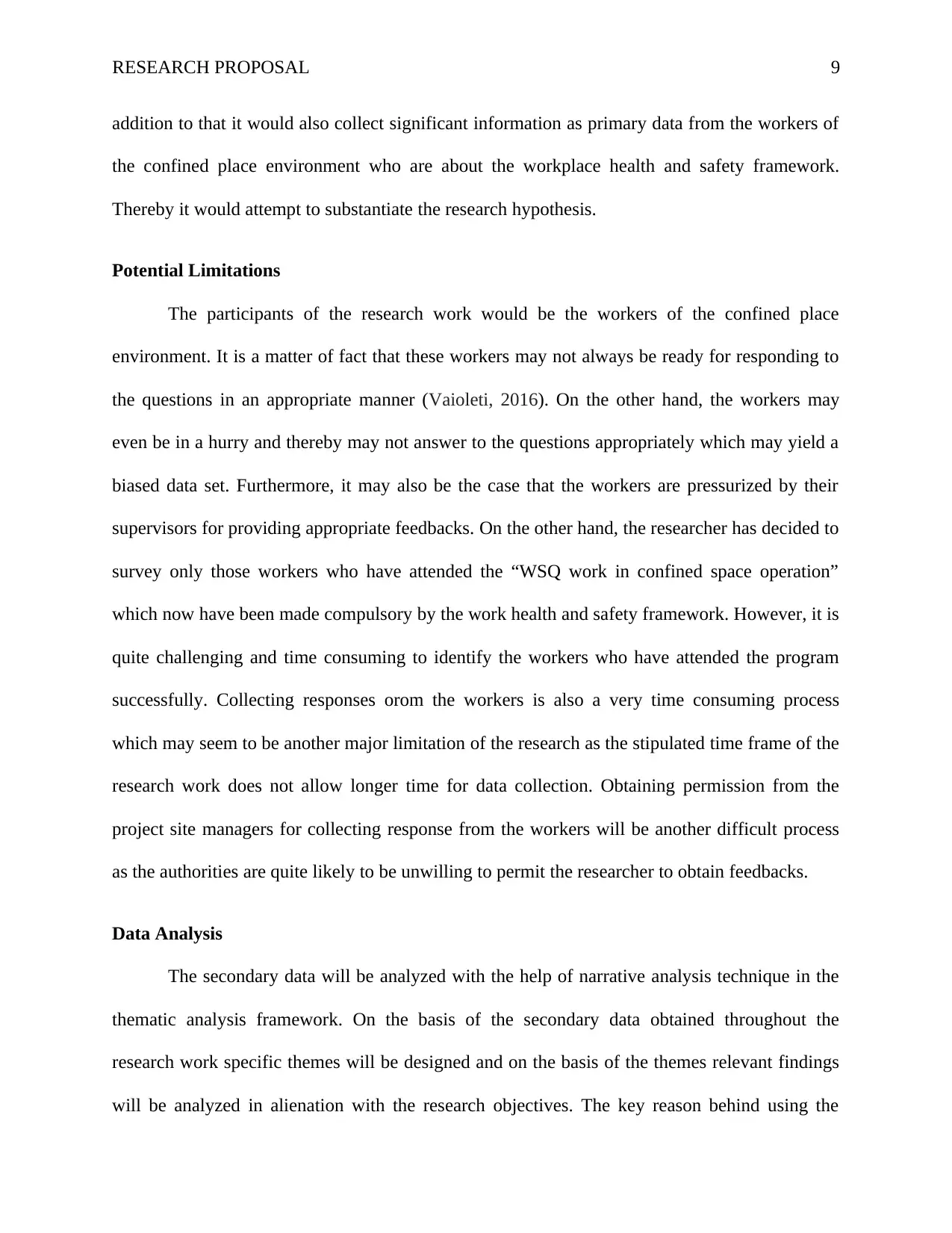
RESEARCH PROPOSAL 9
addition to that it would also collect significant information as primary data from the workers of
the confined place environment who are about the workplace health and safety framework.
Thereby it would attempt to substantiate the research hypothesis.
Potential Limitations
The participants of the research work would be the workers of the confined place
environment. It is a matter of fact that these workers may not always be ready for responding to
the questions in an appropriate manner (Vaioleti, 2016). On the other hand, the workers may
even be in a hurry and thereby may not answer to the questions appropriately which may yield a
biased data set. Furthermore, it may also be the case that the workers are pressurized by their
supervisors for providing appropriate feedbacks. On the other hand, the researcher has decided to
survey only those workers who have attended the “WSQ work in confined space operation”
which now have been made compulsory by the work health and safety framework. However, it is
quite challenging and time consuming to identify the workers who have attended the program
successfully. Collecting responses orom the workers is also a very time consuming process
which may seem to be another major limitation of the research as the stipulated time frame of the
research work does not allow longer time for data collection. Obtaining permission from the
project site managers for collecting response from the workers will be another difficult process
as the authorities are quite likely to be unwilling to permit the researcher to obtain feedbacks.
Data Analysis
The secondary data will be analyzed with the help of narrative analysis technique in the
thematic analysis framework. On the basis of the secondary data obtained throughout the
research work specific themes will be designed and on the basis of the themes relevant findings
will be analyzed in alienation with the research objectives. The key reason behind using the
addition to that it would also collect significant information as primary data from the workers of
the confined place environment who are about the workplace health and safety framework.
Thereby it would attempt to substantiate the research hypothesis.
Potential Limitations
The participants of the research work would be the workers of the confined place
environment. It is a matter of fact that these workers may not always be ready for responding to
the questions in an appropriate manner (Vaioleti, 2016). On the other hand, the workers may
even be in a hurry and thereby may not answer to the questions appropriately which may yield a
biased data set. Furthermore, it may also be the case that the workers are pressurized by their
supervisors for providing appropriate feedbacks. On the other hand, the researcher has decided to
survey only those workers who have attended the “WSQ work in confined space operation”
which now have been made compulsory by the work health and safety framework. However, it is
quite challenging and time consuming to identify the workers who have attended the program
successfully. Collecting responses orom the workers is also a very time consuming process
which may seem to be another major limitation of the research as the stipulated time frame of the
research work does not allow longer time for data collection. Obtaining permission from the
project site managers for collecting response from the workers will be another difficult process
as the authorities are quite likely to be unwilling to permit the researcher to obtain feedbacks.
Data Analysis
The secondary data will be analyzed with the help of narrative analysis technique in the
thematic analysis framework. On the basis of the secondary data obtained throughout the
research work specific themes will be designed and on the basis of the themes relevant findings
will be analyzed in alienation with the research objectives. The key reason behind using the
Paraphrase This Document
Need a fresh take? Get an instant paraphrase of this document with our AI Paraphraser
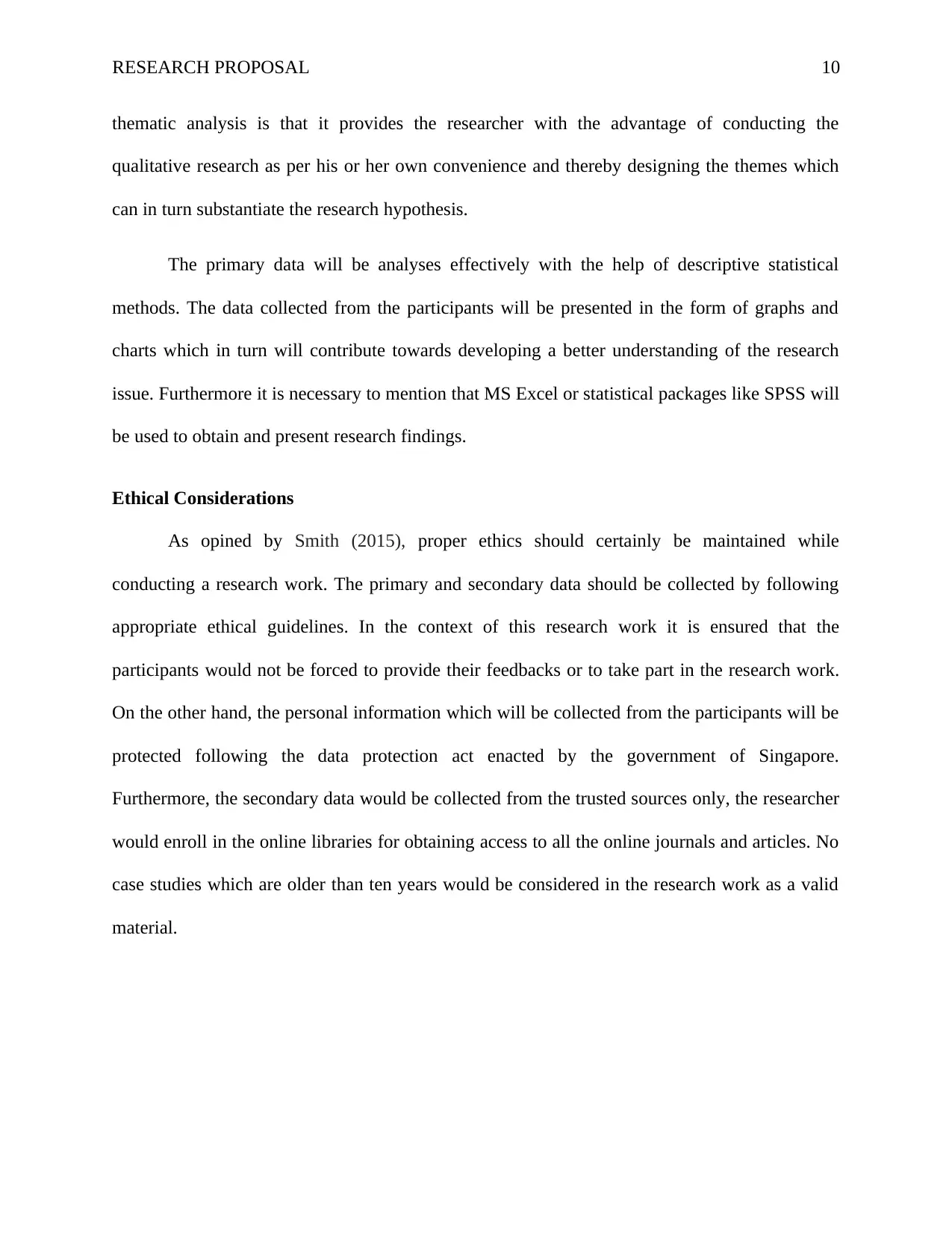
RESEARCH PROPOSAL 10
thematic analysis is that it provides the researcher with the advantage of conducting the
qualitative research as per his or her own convenience and thereby designing the themes which
can in turn substantiate the research hypothesis.
The primary data will be analyses effectively with the help of descriptive statistical
methods. The data collected from the participants will be presented in the form of graphs and
charts which in turn will contribute towards developing a better understanding of the research
issue. Furthermore it is necessary to mention that MS Excel or statistical packages like SPSS will
be used to obtain and present research findings.
Ethical Considerations
As opined by Smith (2015), proper ethics should certainly be maintained while
conducting a research work. The primary and secondary data should be collected by following
appropriate ethical guidelines. In the context of this research work it is ensured that the
participants would not be forced to provide their feedbacks or to take part in the research work.
On the other hand, the personal information which will be collected from the participants will be
protected following the data protection act enacted by the government of Singapore.
Furthermore, the secondary data would be collected from the trusted sources only, the researcher
would enroll in the online libraries for obtaining access to all the online journals and articles. No
case studies which are older than ten years would be considered in the research work as a valid
material.
thematic analysis is that it provides the researcher with the advantage of conducting the
qualitative research as per his or her own convenience and thereby designing the themes which
can in turn substantiate the research hypothesis.
The primary data will be analyses effectively with the help of descriptive statistical
methods. The data collected from the participants will be presented in the form of graphs and
charts which in turn will contribute towards developing a better understanding of the research
issue. Furthermore it is necessary to mention that MS Excel or statistical packages like SPSS will
be used to obtain and present research findings.
Ethical Considerations
As opined by Smith (2015), proper ethics should certainly be maintained while
conducting a research work. The primary and secondary data should be collected by following
appropriate ethical guidelines. In the context of this research work it is ensured that the
participants would not be forced to provide their feedbacks or to take part in the research work.
On the other hand, the personal information which will be collected from the participants will be
protected following the data protection act enacted by the government of Singapore.
Furthermore, the secondary data would be collected from the trusted sources only, the researcher
would enroll in the online libraries for obtaining access to all the online journals and articles. No
case studies which are older than ten years would be considered in the research work as a valid
material.
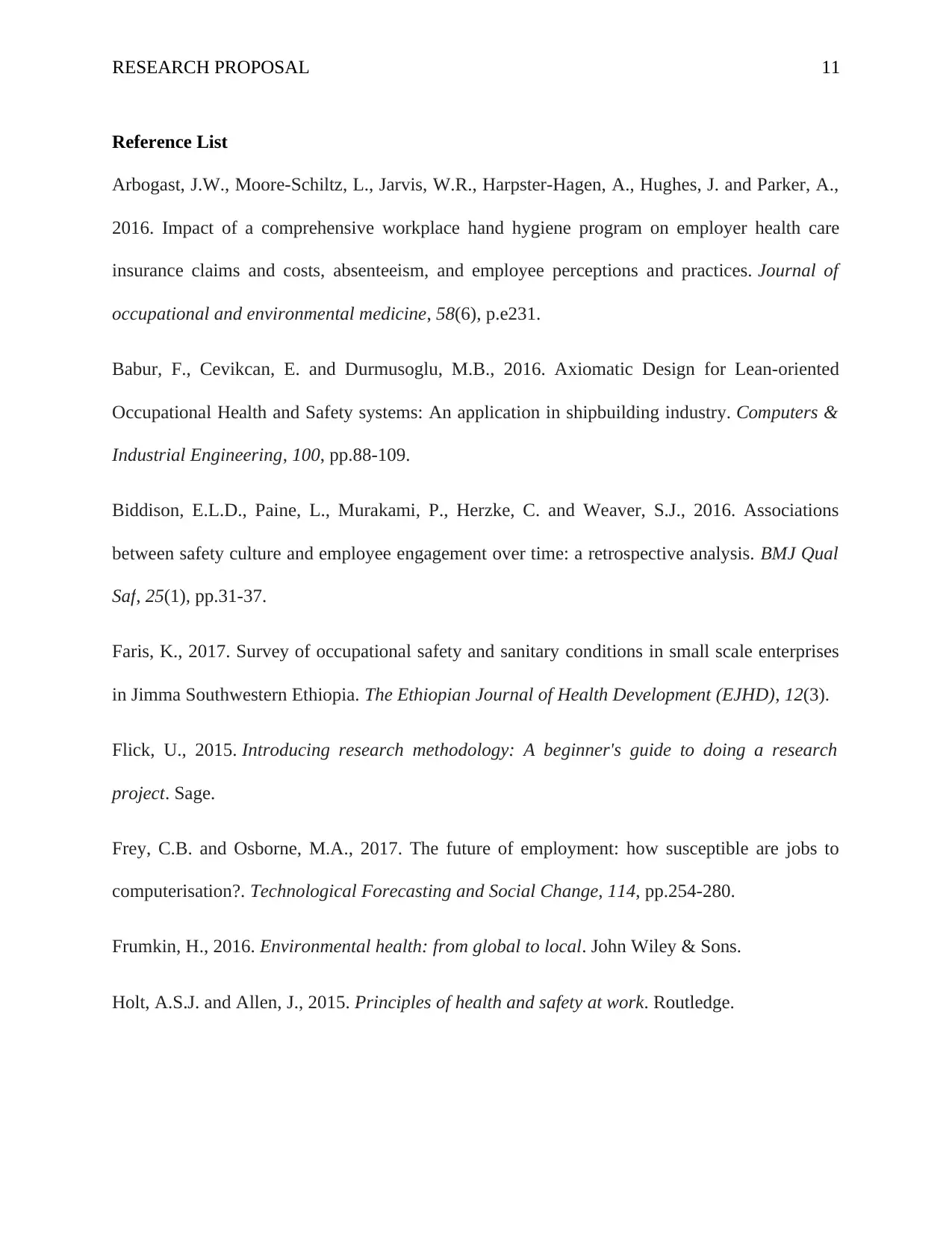
RESEARCH PROPOSAL 11
Reference List
Arbogast, J.W., Moore-Schiltz, L., Jarvis, W.R., Harpster-Hagen, A., Hughes, J. and Parker, A.,
2016. Impact of a comprehensive workplace hand hygiene program on employer health care
insurance claims and costs, absenteeism, and employee perceptions and practices. Journal of
occupational and environmental medicine, 58(6), p.e231.
Babur, F., Cevikcan, E. and Durmusoglu, M.B., 2016. Axiomatic Design for Lean-oriented
Occupational Health and Safety systems: An application in shipbuilding industry. Computers &
Industrial Engineering, 100, pp.88-109.
Biddison, E.L.D., Paine, L., Murakami, P., Herzke, C. and Weaver, S.J., 2016. Associations
between safety culture and employee engagement over time: a retrospective analysis. BMJ Qual
Saf, 25(1), pp.31-37.
Faris, K., 2017. Survey of occupational safety and sanitary conditions in small scale enterprises
in Jimma Southwestern Ethiopia. The Ethiopian Journal of Health Development (EJHD), 12(3).
Flick, U., 2015. Introducing research methodology: A beginner's guide to doing a research
project. Sage.
Frey, C.B. and Osborne, M.A., 2017. The future of employment: how susceptible are jobs to
computerisation?. Technological Forecasting and Social Change, 114, pp.254-280.
Frumkin, H., 2016. Environmental health: from global to local. John Wiley & Sons.
Holt, A.S.J. and Allen, J., 2015. Principles of health and safety at work. Routledge.
Reference List
Arbogast, J.W., Moore-Schiltz, L., Jarvis, W.R., Harpster-Hagen, A., Hughes, J. and Parker, A.,
2016. Impact of a comprehensive workplace hand hygiene program on employer health care
insurance claims and costs, absenteeism, and employee perceptions and practices. Journal of
occupational and environmental medicine, 58(6), p.e231.
Babur, F., Cevikcan, E. and Durmusoglu, M.B., 2016. Axiomatic Design for Lean-oriented
Occupational Health and Safety systems: An application in shipbuilding industry. Computers &
Industrial Engineering, 100, pp.88-109.
Biddison, E.L.D., Paine, L., Murakami, P., Herzke, C. and Weaver, S.J., 2016. Associations
between safety culture and employee engagement over time: a retrospective analysis. BMJ Qual
Saf, 25(1), pp.31-37.
Faris, K., 2017. Survey of occupational safety and sanitary conditions in small scale enterprises
in Jimma Southwestern Ethiopia. The Ethiopian Journal of Health Development (EJHD), 12(3).
Flick, U., 2015. Introducing research methodology: A beginner's guide to doing a research
project. Sage.
Frey, C.B. and Osborne, M.A., 2017. The future of employment: how susceptible are jobs to
computerisation?. Technological Forecasting and Social Change, 114, pp.254-280.
Frumkin, H., 2016. Environmental health: from global to local. John Wiley & Sons.
Holt, A.S.J. and Allen, J., 2015. Principles of health and safety at work. Routledge.
⊘ This is a preview!⊘
Do you want full access?
Subscribe today to unlock all pages.

Trusted by 1+ million students worldwide
1 out of 14
Related Documents
Your All-in-One AI-Powered Toolkit for Academic Success.
+13062052269
info@desklib.com
Available 24*7 on WhatsApp / Email
![[object Object]](/_next/static/media/star-bottom.7253800d.svg)
Unlock your academic potential
Copyright © 2020–2025 A2Z Services. All Rights Reserved. Developed and managed by ZUCOL.





